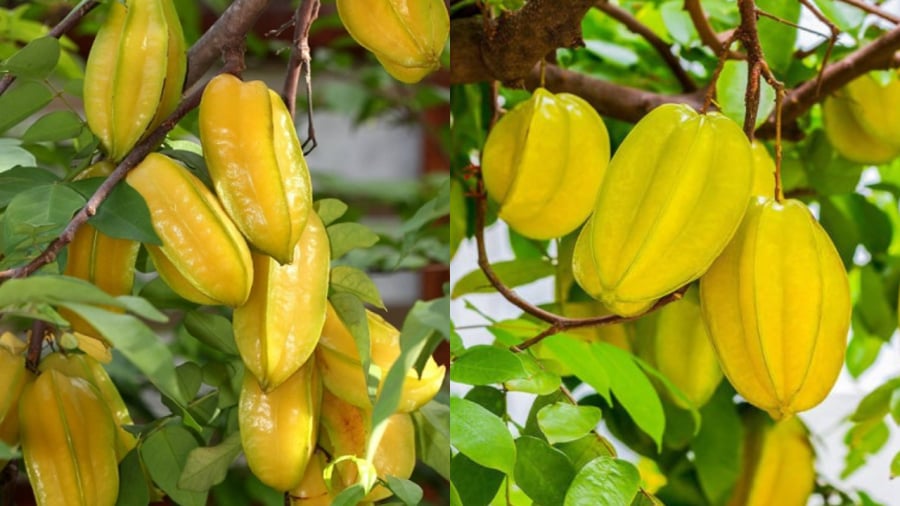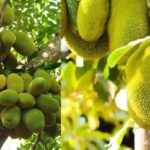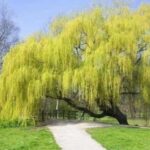The Carambola tree is a familiar fruit tree to the Vietnamese. It even appears frequently in fairy tales and poetry. Besides bearing sweet fruits and providing shade, the Carambola tree also has medicinal properties. The fruits have a fever-reducing, hemostatic, diuretic, and hemorrhoid-relieving effects. The sour leaves possess cooling and anti-inflammatory properties, and they aid in treating urticaria and allergies. The bark and root bark help alleviate joint pain, stomach inflammation, and headaches. The flowers are used in remedies for wet and dry coughs, dysentery, malaria, and kidney health.
In addition to its practical uses, the Carambola tree is also considered a lucky plant in Feng Shui. It is believed to attract wealth and good fortune.
Where should you plant a Carambola tree to attract the most wealth?
Traditionally, families would plant Carambola trees in their gardens for shade and fruit. However, in recent years, people have started growing them in pots and shaping them into bonsai trees for Feng Shui purposes.
According to folk beliefs, the Carambola tree symbolizes honesty and sincerity. The flowers and fruits hang in clusters, representing unity and family reunion. The golden-yellow fruits symbolize luck, prosperity, and abundant wealth. Many believe that planting a Carambola tree in their garden or in front of their house will bring great luck and a prosperous life filled with wealth and happiness for generations.

Planting a Carambola tree in front of your house invites wealth.
Homeowners can choose to plant a Carambola tree in front of their house for both decorative and lucky purposes. When planting in front of a house, ensure that the tree doesn’t block the pathway or entrance, creating inconvenience and obstructing the flow of positive energy and wealth into the home.
Carambola trees can grow up to 3-5 meters in height, with lush branches, so consider this when planting near your home. If you have ample space, go ahead and plant it. For narrower lots, consider growing a bonsai version in a pot.
In terms of Feng Shui, homeowners can plant either the sour or sweet variety, as it doesn’t affect the attraction of wealth. However, if you want to be precise with the symbolism, you can plant the sweet variety to represent sweetness and warmth, wishing for a happy and fulfilled family life.
Which birth sign is most compatible with the Feng Shui Carambola tree?
The Carambola tree holds auspicious meanings in Feng Shui and is a popular and easy-to-grow plant. It suits all birth signs, and anyone can benefit from growing it. However, if we consider the specific elements, the Carambola tree, with its brown trunk, green leaves, and vibrant yellow fruits when ripe, is most suitable for those of the Fire and Earth birth signs. For these individuals, planting a Carambola tree in their garden or in front of their house can stimulate wealth, attract good luck, and bring prosperity and blessings to their descendants.
How to Plant and Care for a Carambola Tree
Carambola trees are easy to grow and don’t require complicated care. You can propagate them through grafting and cutting or buy seedlings from plant stores. Both methods are straightforward and ensure the tree’s survival.
While Carambola trees aren’t picky about soil type, they thrive best in loose, porous loam soil with a pH of 5.5. Enrich the soil with compost, manure, and organic matter to boost the tree’s growth and fruit production.
Carambola trees love sunlight, so choose a sunny spot when planting. Ensure to water the tree regularly, keeping the soil moist.
When the tree reaches about a meter in height, you can start pruning. Remove diseased, dry, or weak branches and thin out the smaller, delicate branches to encourage airflow and healthy growth. It’s best to prune after the harvest and before the tree starts flowering again.
This information is for reference only and is subject to individual interpretation.
“The Mystery of the Jackfruit Tree: Why Ancestors Loved and Loathed it”
Mango wood is a precious natural resource, often revered for its beauty and unique characteristics. However, there is a traditional belief that planting mango trees in front of houses is inauspicious. Superstitions aside, this wood has a rich history and is highly sought-after for its durability and aesthetic appeal.
3 Signs of Impending Good Fortune: A Guide to Recognizing and Embracing Upcoming Prosperity.
The key to a successful future lies within these three traits: perseverance, adaptability, and a dash of good fortune. Those who embody these qualities will undoubtedly unlock a world of prosperity and abundance. It’s not just about hard work, but also about embracing change and seizing the opportunities that life presents. So, embrace your destiny and let your fortunes soar.
The Ancient Wisdom Uncovered: “The 5 Trees of Doom: Plant These and Watch Your Fortune Vanish”
The ancient belief that these five trees could bring bad luck and affect the prosperity of a household is an intriguing one. However, it is important to note that these beliefs are just that – ancient superstitions. In reality, these trees, like all flora, have their own unique beauty and ecological significance.
Why Did the Ancients Say: Foolish to Build a House Facing West, and Sillier Still to Buy Land Next to a Temple?
Purchasing land and building a house is a significant decision that requires careful consideration. It is a complex and often daunting process that can be overwhelming for many individuals. With a myriad of factors to contemplate, from location and budget to legalities and design preferences, it’s essential to approach this endeavor with prudence and foresight.



































